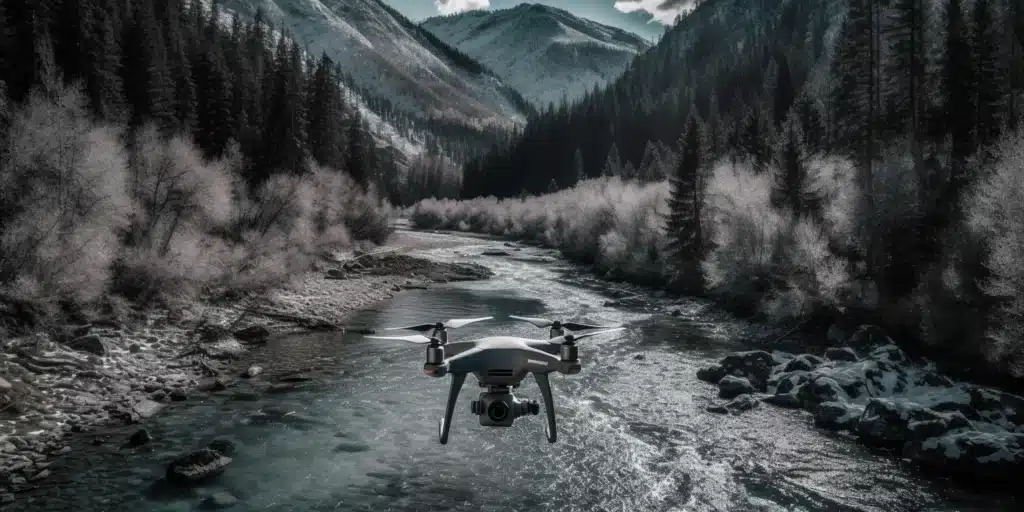Drones have become an essential tool in disaster relief efforts, revolutionizing the way we respond to natural catastrophes. In this article, we’ll explore how drones are helping in Oklahoma’s disaster recovery efforts and how Blue Falcon Aerial, a local Oklahoma company, is playing a crucial role in these life-saving missions. The importance of local expertise cannot be understated, as it ensures a deep understanding of the unique challenges faced in the region and the ability to respond quickly and effectively.
The Role of Drones in Disaster Recovery
Aerial Surveying and Damage Assessment
Drones have proven to be invaluable tools for aerial surveying and damage assessment during disaster relief efforts. They can quickly and accurately capture high-resolution images and videos of affected areas, enabling emergency responders to assess the extent of damage, identify priority areas, and allocate resources more efficiently. This drone-assisted disaster response in Oklahoma has been crucial in speeding up recovery efforts after tornadoes, floods, and wildfires.
Search and Rescue Operations
Drones are also essential in search and rescue operations during disasters. Equipped with thermal imaging cameras and night vision capabilities, they can quickly locate survivors in hard-to-reach areas or hazardous conditions. These drones for search and rescue in Oklahoma disasters have helped save lives by allowing emergency responders to reach and assist those in need more quickly and safely.
Infrastructure Inspection and Repair
Drones can inspect damaged infrastructure such as bridges, roads, and power lines, providing crucial information to facilitate timely repairs. They can access areas that may be difficult or dangerous for humans to reach, ensuring safety and reducing the time it takes to restore essential services. Using drones for post-disaster damage assessments in Oklahoma has been instrumental in reducing downtime and aiding in a quicker return to normalcy for affected communities.
Delivery of Essential Supplies
Drones can also deliver essential supplies such as food, water, and medical aid to disaster-stricken areas, particularly when conventional transportation methods are disrupted or too risky. Aerial delivery can be a lifesaver in situations where roads are blocked, flooded, or destroyed, ensuring that affected communities receive the necessary support during critical moments.
Benefits of Using Drones in Disaster Relief
Enhanced Response Time
Drones can be deployed rapidly, providing real-time information to emergency responders and reducing the time it takes to assess damage and initiate rescue operations. This advantage is particularly crucial during the initial stages of disaster relief when time is of the essence.
Increased Efficiency and Effectiveness
Drones can cover large areas quickly and provide high-resolution images and data, enabling emergency responders to make informed decisions and prioritize resources. This increased efficiency and effectiveness in disaster relief efforts ultimately result in better outcomes for affected communities.
Cost-saving Benefits
Drones can be more cost-effective than traditional methods, such as manned aircraft, for disaster relief operations. They require fewer resources and personnel, and their ability to gather accurate information quickly can result in significant savings for both government agencies and nonprofit organizations involved in disaster relief efforts.
Safety and Risk Mitigation
By using drones, disaster relief teams can minimize the risks associated with human entry into hazardous areas. Drones can navigate through dangerous conditions, such as toxic gas leaks or unstable structures, ensuring that emergency responders can safely assess and address the situation without putting their lives in danger.
Types of Drones Used for Disaster Relief in Oklahoma
Fixed-Wing Drones
Fixed-wing drones are designed with rigid wings similar to traditional airplanes, enabling them to fly long distances and stay in the air for extended periods. This endurance makes fixed-wing drones ideal for aerial surveys and disaster relief efforts in Oklahoma, where they can cover large areas quickly and efficiently.
Multirotor Drones
Multirotor drones, such as quadcopters and hexacopters, are equipped with multiple rotors that allow them to hover, maneuver with precision, and take off and land vertically. These drones are well-suited for search and rescue operations, infrastructure inspections, and delivering essential supplies in disaster-stricken areas. Their agility and ability to access hard-to-reach locations make them indispensable in disaster relief efforts.
Hybrid Drones
Hybrid drones combine the advantages of fixed-wing and multirotor drones, offering both endurance and maneuverability. These versatile drones can cover vast distances while still providing the precision needed for search and rescue operations or infrastructure inspections. Hybrid drones are increasingly being used in Oklahoma for disaster relief efforts, bringing added flexibility and efficiency to emergency response teams.
Oklahoma’s Drone Industry Readiness
State Rankings
Oklahoma has made significant strides in embracing drone technology for disaster relief and other applications. The state has consistently ranked high in terms of drone industry readiness, with progressive policies and robust support for research and development. This commitment to fostering innovation has helped Oklahoma become a leading player in the drone industry, further enhancing its ability to respond to disasters effectively.
Drone-Friendly Policies
Oklahoma has implemented drone-friendly policies that encourage the use of this technology for disaster relief and other beneficial applications. These policies have created a favorable environment for drone operators and businesses, enabling them to contribute to the state’s disaster recovery efforts more effectively.
Oklahoma State University Disaster Relief Drones
Oklahoma State University (OSU) has played a pivotal role in advancing drone technology for disaster relief. OSU’s Unmanned Systems Research Institute has developed cutting-edge drones specifically designed for disaster response, further bolstering Oklahoma’s capacity to deal with natural catastrophes. These drones have been used in various disaster scenarios, including tornado recovery and flood management, showcasing their potential to save lives and reduce damage.
Nonprofit Organizations and Drones in Disaster Relief
Collaboration and Support
Nonprofit organizations play a crucial role in disaster relief efforts, often working hand-in-hand with government agencies and local communities. Many of these organizations have recognized the potential of drones in enhancing their response capabilities and have incorporated drone technology into their operations. By collaborating with drone operators and businesses, nonprofits can optimize resource allocation, improve efficiency, and ultimately save more lives during disaster response efforts.
Local and International Initiatives
Numerous local and international nonprofit organizations are actively involved in drone-assisted disaster relief efforts in Oklahoma. They provide crucial support in areas such as search and rescue, damage assessment, and supply delivery. These initiatives demonstrate the growing recognition of drone technology’s potential to improve disaster response and recovery outcomes, both in Oklahoma and around the world.
Challenges in Using Drones for Disaster Relief Efforts
Regulatory Hurdles
Despite the numerous advantages of drones in disaster relief efforts, regulatory challenges can sometimes hinder their full potential. Strict airspace regulations and the need for proper certifications and permissions can delay drone deployment in time-sensitive disaster scenarios. However, ongoing efforts to streamline these processes and create more flexible regulations for emergency situations are helping to overcome these hurdles.
Privacy Concerns
Privacy concerns are another challenge in using drones for disaster relief efforts. The use of drones to capture aerial images and videos can raise concerns about potential privacy violations, especially in residential areas. To address these concerns, disaster relief teams must adhere to best practices that respect privacy rights while still ensuring the effective use of drone technology.
Technical Limitations
Although drones have come a long way in terms of technological advancements, they still face some limitations that can impact their effectiveness in disaster relief efforts. Factors such as limited battery life, range restrictions, and susceptibility to weather conditions can all pose challenges to drone operations. However, ongoing research and development are focused on overcoming these limitations and enhancing drone capabilities for disaster relief and other applications.
Weather Conditions
Adverse weather conditions, such as strong winds, heavy rain, or dense fog, can impede drone operations during disaster relief efforts. Drones may struggle to maintain stable flight or capture clear images in challenging weather, potentially hindering their effectiveness. Disaster relief teams must carefully consider these factors when planning and executing drone missions to ensure optimal results.
Case Studies of Drone Usage in Oklahoma Disaster Relief
Tornado Recovery
Oklahoma is no stranger to tornadoes, and drones have been instrumental in improving response and recovery efforts. After a tornado strikes, drones can quickly assess the damage, enabling responders to prioritize resources and provide targeted assistance to affected communities. Drones can also help identify safe routes for emergency vehicles, ensuring that help arrives as quickly as possible.
Flood Management
Floods are another common natural disaster in Oklahoma, and drones have proven to be valuable tools in managing these events. Aerial surveys for disaster relief efforts in Oklahoma can help monitor floodwaters, identify vulnerable areas, and support evacuation planning. In addition, drones can be used to inspect infrastructure such as levees and dams, ensuring that potential hazards are addressed before they escalate.
Wildfire Containment
Drones have also been deployed in Oklahoma to assist with wildfire containment efforts. Equipped with thermal imaging cameras, drones can detect hotspots and monitor the spread of wildfires in real-time. This information is invaluable to firefighters, enabling them to strategically allocate resources and protect vulnerable communities.
Blue Falcon Aerial’s Contributions to Disaster Recovery in Oklahoma
Local Expertise and Commitment
As a local Oklahoma company, Blue Falcon Aerial is deeply committed to supporting disaster recovery efforts in the state. Their team of experts understands the unique challenges that Oklahoma faces and is dedicated to providing tailored drone solutions that address the specific needs of affected communities.
Advanced Drone Technology
Blue Falcon Aerial uses state-of-the-art drone technology, ensuring that their services are both efficient and effective. By staying at the forefront of industry advancements, they can provide cutting-edge solutions that enhance disaster recovery efforts in Oklahoma.
Community Engagement and Collaboration
Blue Falcon Aerial actively engages with local communities, government agencies, and nonprofit organizations to support disaster recovery efforts. By fostering strong relationships and collaborations, they are better equipped to provide the assistance needed during challenging times. This commitment to community engagement and collaboration is a testament to Blue Falcon Aerial’s dedication to making a positive impact in Oklahoma.
In conclusion, drones have significantly transformed the landscape of disaster relief in Oklahoma, enhancing response time, increasing efficiency, and reducing risks to human lives. Blue Falcon Aerial, as a local Oklahoma business, has been instrumental in these efforts, bringing advanced drone technology and invaluable expertise to the table. If you need any drone services or want to learn more about how Blue Falcon Aerial is making a difference in Oklahoma, don’t hesitate to visit their website and reach out to them for more information. Together, we can continue to improve disaster recovery and make our communities safer and more resilient.




